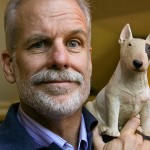Chris Van Allsburg, the author/illustrator of The Polar Express, graduated from the Rhode Island School of Design in 1975 as a sculptor. Within two years of opening his own studio, he had the opportunity to exhibit his work in what he calls “a bona fide New York City gallery”—an opportunity made sweeter by the sale of a few pieces.
Icy cold Northeast winters forced Van Allsburg out of his studio. Situated in a large factory building, Van Allsburg’s studio “stuck out from the main building like a finger on a glove” and was impossible to keep warm in the evening. “I had a drafting table at home and I amused myself by drawing pictures,” he says. Although his pictures had a narrative quality, he was not concerned about the story they told. His wife encouraged him to submit his drawings to a children’s publisher, but Van Allsubrg was unenthused. “In the world of fine art, illustration is too commercial. I didn’t want to be enslaved by text, or worse, by an art director.”
Nevertheless, Van Allsburg drew because Rhode Island winters are long and cold. It occurred to him that to retain control of his work he could write his own stories and illustrate them. At the time, Van Allsburg had a strong interest in topiary. Using topiary gardens as a backdrop in The Garden of Abdul Gasazi (1979), Van Allsburg added a boy chasing a dog, which led him to ask himself who is the boy and to whom do the topiaries belong? “The story revealed itself with the answers to these question,” says Van Allsburg. “It was a process of discovery rather than a process of creativity, as if the story already existed and I hadn’t looked for it yet.” The story compares stage magic to real magic, a premise Van Allsburg had not set out to write about. “I was pleased and satisfied that the book led to an idea that had substance, and was presented in a way to engage children and encourage them to puzzle out the answers.”
Van Allsurg sent his book to Houghton Mifflin with low expectations of it being well-received. “I didn’t see anything on the market like my pictures,” says Van Allsburg. “Black and white pencil sketches.” Spring brought warmer weather to Rhode Island, and he returned to sculpting. When The Garden of Abdul Gasazi won the Caldecott Honor Medal he said, “I could do much better if I try again.” He laid down his chisels and clay and wrote Jumanji (1981), a Caldecott Medal winner and later a feature film starring Robin Williams.
Van Allsburg does not remember making a conscious decision in favor of writing and illustrating instead of sculpting. “I slowly started making less and less sculpture and spending more and more time with books.” Van Allsburg found parallels between book making and sculpting. He chooses the size of his books, the paper, and the binding, and designs the covers. “I like the physical-ness of books. As a whole it is a piece of art that deserves guidance from its creator.” And he still finds uses for his clay, often sculpting a quick model to determine the shape of the object’s cast shadow in order to draw it on paper.
In his newest book, Probuditi!, Van Allsburg uses warm sepia tones on creamy paper to suggest time past and to convey the heat of the summer day setting in the book. He also employs a folk tale archetype where a powerless person triumphs over a more powerful person through the use of deception. Calvin’s younger sister turns the tables on him when he attempts to hypnotize her. “It’s a tale of a trickster being tricked by his own trick,” quips Van Allsburg. Taking his title from a Serbo-Croation word meaning “awaken”, Van Allsburg says, “I have admiration and appreciation for a publisher willing to publishing a book with an unpronounceable title.’
Readers acquainted with Van Allsburg’s work appreciate his plot twists and turns. His books stimulate our imaginations, none better than The Mysteries of Harris Burdick(1984). At a flea market, Van Allsburg saw dealers cut up books and sell the pictures individually because they were worth more. Each picture had a measure of interest and intrigue, but combined with a caption, took on an unexpected vitality—the crux of his idea for The Mysteries of Harris Burdick. Van Allsburg leaves it up to his readers to sort out the fact from the fiction in this book.
The process of coming up with an idea for a book is more organic for Van Allsburg than revisiting his childhood. A worthy idea is something that “would utterly thrill and mystify me” as a child. Each book has his complete attention as he’s working on it. He incorporates and builds on his previous books to make this new project better in some way. Otherwise, he says, “There’s no point in doing it.”


